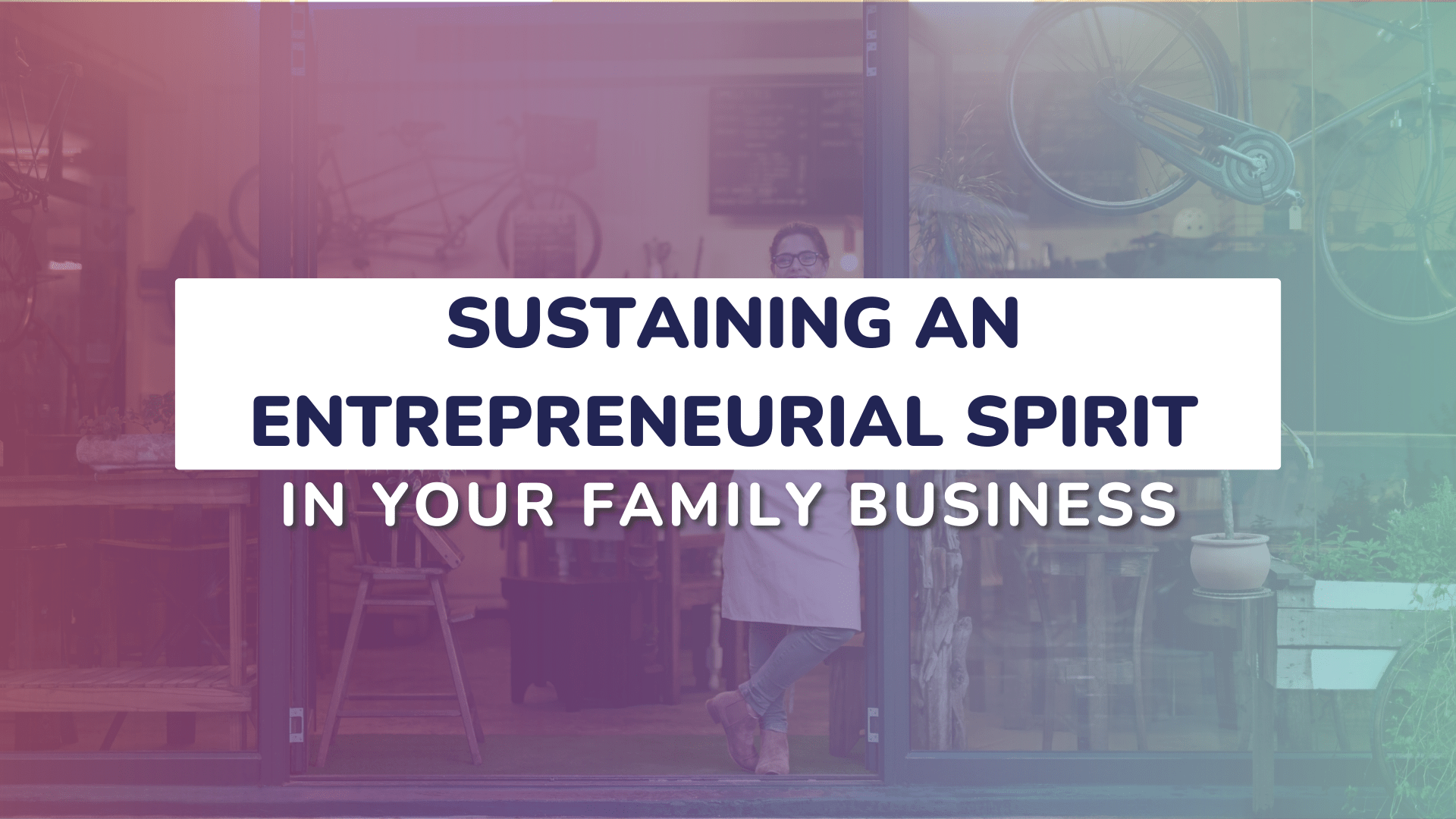Sustaining an Entrepreneurial Spirit in Your Family Business
During the crisis of the pandemic, Matt Allen (the article’s author) conducted research on how family businesses adapted to the pressures of the market context. The research was carried out in the summer of 2020, 6 months after the World Health Organization officially declared Covid-19 a pandemic. The results were very interesting. Matt noticed that “entrepreneurship” was the tool that family businesses used to address relevant issues.
The research has revealed two specific points. First was the sheer magnitude of the overall innovation that was happening as a result of the pandemic. Among the 124 businesses contacted for the study, leaders indicated that, on average, 29% of current sales were the result of changes made since the pandemic began. The fact that nearly a third of current sales were “new” is a testament to the ability of family businesses to adapt quickly in a crisis. Second, we were struck by differences in the overall level of innovation across the generations currently leading the business. Among businesses led by the first generation, a full 38% of current sales were the result of these recent innovations. For businesses led by the 2ndgeneration, sales driven by new innovations dropped to 34%. For businesses led by the 3rd or later generations, only 18% of current sales were coming from changes made since the pandemic began. Furthermore, these differences proved to be independent of the size/complexity of the organizations involved. While the ability to adapt 18% of overall business in a such a short period of time is still significant, the fact that the level was less than half that of first-generation-led businesses caught our attention.
The idea of generational decline in family businesses is nothing new. The old adage “shirtsleeves to shirtsleeves in three generations” seems to exist in one form or another in many cultures and languages. One common explanation for this decrease stems from the idea that next generation members are coddled to the point that they don’t understand or aren’t willing to face the difficulties associated with hard work, including entrepreneurial activity. Additional research argues that as the family business grows and extends across generations, the desire to protect benefits provided by the business leads to a more cautious approach. Regardless of the specific reasoning, the common assumption is that generational decline is driven by a generation gap of sorts, where successive generations become less motivated, and less capable of leading the business.
Several years ago, one of us (Matt) supervised a student-led research project addressing this assumption of an entrepreneurial generation gap in business families. As part of the study, members of multiple generations were interviewed across several large business-owning families. The consistency in the findings across these very different businesses was strikingly similar. Senior generation family leaders almost universally expressed frustration in the rising generations’ unwillingness to “step up” and “take initiative” in order to take the business to the next level through their own entrepreneurial activity. Next generation members were equally consistent in their response. They were respectively frustrated that the senior generation was not clear or consistent in sharing their values or intended strategies for the business in a way that would allow next generation members to take any entrepreneurial action aligned with the desires of their parents.
It is interesting that the interviews did not reveal a true generation gap where the goals and desires of the senior generation were completely dissimilar to those of the next generation. Instead, it seems that inaction was the result of a misalignment between senior and junior generations. Both generations desired the same thing — entrepreneurial action — but the inability to connect was leading to frustration on both sides. Families wishing to encourage entrepreneurial activity in the next generation will need to address this misalignment between generations. Here’s how:
Over-Communicate
When it comes to building an entrepreneurial spirit, a primary source of misalignment is a lack of understanding about expectations and needs. Families tend to get in comfortable communication patterns, which often creates this misalignment. When we teach executive audiences that include family members from two generations, we will often split the generations up and ask each the same set of questions about communication. It is always surprising to both groups how little consistency there is. For example, when asked how well-understood the succession plan is in the family, the senior generation feels as if it is well-communicated and understood, while the next generation members often tell us that they were not even aware there was a plan. The solution to this problem is an intentional effort to over-communicate. Share information, and then share it again. Research indicates that one of the top complaints about business leaders is a lack of clarity in their communication. Leaders tend to think that they communicate more often than they do, and that this communication is clearer than it actually is. Our interviews suggest that over-communication from the senior generation should focus on clearly communicating their desire for self-directed entrepreneurial activity from the next generation.
And the next generation is not immune from a need to over-communicate themselves. Our interviews suggested that the next generation tends to be timid about asking questions and sharing their needs with the senior generation. Next generation members should focus on over-communicating both their desires to meet the entrepreneurial expectations of the senior generation, and their need to better understand the values and strategies held by the senior generation in order to do so. Many of our students approach us after class asking us how to ask their parents questions about the business or their own entrepreneurial ideas. They are generally disappointed when we tell them there is no easy way. They are also generally elated when they finally do raise the question with family and find out that it was not nearly as terrible as they had anticipated. Parents can certainly help in this process by being available and open when questions are asked.
Communication alone is not enough to fully promote entrepreneurship in the next generation. As discussed previously, some people would point to a lack of motivation or drive in the next generation as the cause of this inaction. The interviews would indicate otherwise. Core research in organizational behavior indicates that behavior — action — is driven by three variables: 1) The ability of the individual to take the expected action; 2) the motivation of the individual to take the expected action; and 3) the opportunity provided to the individual to take the expected action. Sometimes referred to as the “AMO theory of motivation (Ability-Motivation-Opportunity),” this research indicates that families should look beyond motivation and focus on enhancing the ability and opportunity of the next generation. Here’s how:
Build capabilities
Despite a popular belief that entrepreneurship is an innate capability, research indicates that entrepreneurship is learned. As families increase the capability of the next generation to act entrepreneurially, they will see more entrepreneurial behavior. Building capability can take place in many ways. We will focus on two here.
First, education. Formal education focused on entrepreneurship has proliferated in recent years. Opportunities exist — from elementary school through graduate school, and from degree programs to community-based education and certificates. Business families should take advantage of these formal educational opportunities to increase the ability of the next generation to act entrepreneurially.
Second, involvement. Next generation members benefit significantly from hands-on learning. To accomplish this, family members should be involved in the business from a young age. In particular, parents should look for opportunities for the next generation to be involved in entrepreneurial efforts that the business is pursuing. Even if they are not ready to be actively involved in decision-making or execution, the power of shadowing leaders, sitting in on meetings, or visiting customers should not be underestimated. One family in the restaurant business took the entire family, from a very young age, to eat at different restaurants (not owned by the family) every weekend. During the drive home, they talked about what they experienced and how it compared to what their restaurants had to offer. By the time these young leaders graduated from high school, they were experts at recognizing opportunities to innovate by analyzing the competition.
Offer leadership opportunities
In addition to having the ability to act entrepreneurially, the next generation also needs to be given the opportunity to do so. Next generation members need a safe space to pursue and test new ideas — to try out their entrepreneurial thinking and experiment with different solutions. Some families provide this space by setting aside resources for next-generation entrepreneurial activity. Next gen members can apply for grants, loans, or equity investments from the family business that allow them to conduct research or even launch a new venture. Other families prefer to keep opportunities within the business, hosting “design challenges” where all family members are invited to develop and submit ideas for solving “real” problems that the family business is facing. Some families are uncomfortable allowing the next generation to engage in business activities and instead allow the next generation to act entrepreneurially in planning family vacations or retreats, enhancing the work of a family foundation, or organizing a family service project. The key with any of these efforts is providing sufficient autonomy so that next generation members truly feel that they have a context or space in which they can really act.
A decline in the entrepreneurial activity of a family business across generations is not inevitable. Rather than focus on significant issues (gaps) between generations, families should focus on correcting misalignments in expectations and needs. Over-communicating around expectations and needs will create more alignment. An emphasis on increasing the entrepreneurial ability of the next generation combined with efforts to provide opportunities for the next generation to act entrepreneurially will increase the willingness of the next generation to take action. There are many differences between each consecutive generation, but an entrepreneurial spirit does not need to be one of them.
Source: https://hbr.org/2022/09/sustaining-an-entrepreneurial-spirit-in-your-family-business
Metta Marketing
Leading Brand Strategy Consultant
SUBSCRIBE TO RECEIVE LATEST UPDATES ON MARKET AND MARKETING.










